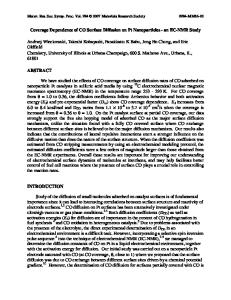CO Coverage Effects on Pt(111) from First-Principles Calculations
- PDF / 527,768 Bytes
- 6 Pages / 612 x 792 pts (letter) Page_size
- 80 Downloads / 282 Views
1084-S03-02
CO Coverage Effects on Pt(111) from First-Principles Calculations Bin Shan, Ligen Wang, Jangsuk Hyun, Yang Sang, Yujun Zhao, and John B Nicholas Nanostellar Inc, 3696 Haven Ave, Redwood City, CA, 94063 ABSTRACT CO saturation coverage on Pt(111) is crucially important in diesel oxidation catalysis. We systematically studied high coverage CO adsorption on the Pt(111) surface using density functional theory (DFT) calculations and classical Monte Carlo (MC) simulations. The zerocoverage limit CO adsorption energy at different binding sites is almost degenerate at the revised Perdew–Burke–Erzernhof functional (RPBE) level. As CO populates the surface, strong throughspace repulsion and substrate-mediated metal sharing tends to dominate the stability of adsorbates and alter their binding preferences. The calculated differential binding energy curve and adsorption patterns compare well with experiments.
INTRODUCTION CO adsorption on Pt surfaces is one of the fundamental steps in diesel engine oxidation catalysis. One of the key parameters that determine the reaction kinetics is CO saturation adsorption. There have been many experimental determinations of CO saturation coverage. However, due to various experimental conditions employed, estimates range from 0.5 monolayer (ML) to 0.7 ML [1-6]. For example, LEED measurements report a saturation coverage of 0.68 ML [1] and 0.71 ML [2], while both electron energy loss spectroscopy (EELS) studies [3] and STM studies [4] indicate adsorbed CO saturates at 0.50 ML with a c(4x2) structure. High pressure STM measurements indicate CO coverage up to 0.7 ML [5,6]. On the theoretical side, CO binding energies have been explored on the many transition metal surfaces [3,7-11]. In particular, CO adsorption on Pt(111) surface has been extensively studied [7,9-11]. The accuracy of different exchange-correlation functionals in predicting CO energies on different adsorption sites was also evaluated [8,12]. Experimental results indicate that at low coverage, CO prefers to bind to atop sites while DFT calculations consistently predict that CO prefers adsorption at hollow sites. The discrepancy is generally attributed to the over estimation of the HOMO-LUMO gap of CO [8,12,13]. A number of theoretical methods have been proposed to correct this problem [13]. Few studies have investigated the CO adsorption at high coverage limit. Hafner et al. [14] have studied CO adsorption with pre-covered CO molecules, but only with a limited set of adsorption configurations. Under realistic diesel operating conditions, the surface is initially saturated with CO molecules. We thus sought to determine the saturation coverage of CO on Pt(111) surface via DFT calculations [15]. Combining DFT calculations and classical Monte-Carlo (MC) techniques, we have theoretically determined the CO differential binding energy curve and saturation coverage, which agree well with experiments.
COMPUTATIONAL METHODS The DFT calculations were done using the Vienna Ab-initio Simulation Package (VASP) [17], where Kohn-Sha
Data Loading...











